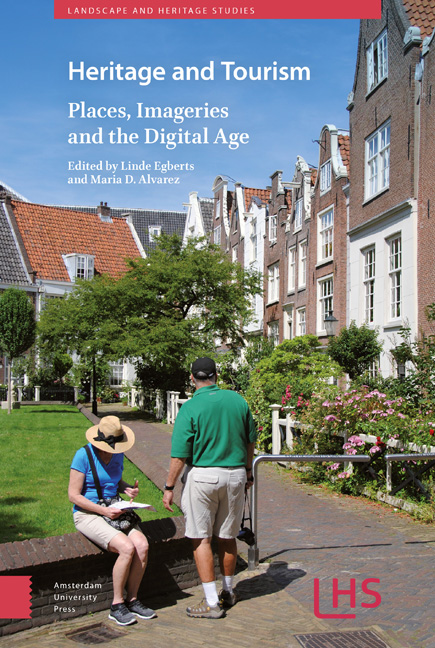Book contents
- Frontmatter
- Dedication
- Contents
- List of Figures and Tables
- Foreword
- 1 Tourism and Heritage: Crafting Experiences Through Innovation
- 2 Tourism Conflicts and Conflict Tourism: Curating “Holoscapes” in Europe’s Age of Crisis
- 3 Heritage Landscapes of Hiroshima and Nagasaki
- 4 Revealing and Presenting the Past(s) for the Public: Fethiye Mosque and Museum as a Cultural Heritage Site in Istanbul
- 5 Who Takes the Lead in Initiating Cooperation in a Cultural Network and Why?: The case study of a Rural Finnish Destination
- 6 Sustainability of Heritage-Tourism Destinations: A Demand-Based Perspective on Cusco, Peru
- 7 Localising National Tourism Websites: The case of World Heritage sites
- 8 Enhancing the Tourist Heritage Experience through “In-Situ”, Customisable, 3D-Printed Souvenirs
- 9 Tracking the Heritage Tourist: Heritage tourism and Visiting Patterns in a Historic City
- 10 The Construction of a Tourist-Historic Icon: The case of the Palace of Westminster, London
- 11 Conclusion
- Index
3 - Heritage Landscapes of Hiroshima and Nagasaki
Published online by Cambridge University Press: 22 December 2020
- Frontmatter
- Dedication
- Contents
- List of Figures and Tables
- Foreword
- 1 Tourism and Heritage: Crafting Experiences Through Innovation
- 2 Tourism Conflicts and Conflict Tourism: Curating “Holoscapes” in Europe’s Age of Crisis
- 3 Heritage Landscapes of Hiroshima and Nagasaki
- 4 Revealing and Presenting the Past(s) for the Public: Fethiye Mosque and Museum as a Cultural Heritage Site in Istanbul
- 5 Who Takes the Lead in Initiating Cooperation in a Cultural Network and Why?: The case study of a Rural Finnish Destination
- 6 Sustainability of Heritage-Tourism Destinations: A Demand-Based Perspective on Cusco, Peru
- 7 Localising National Tourism Websites: The case of World Heritage sites
- 8 Enhancing the Tourist Heritage Experience through “In-Situ”, Customisable, 3D-Printed Souvenirs
- 9 Tracking the Heritage Tourist: Heritage tourism and Visiting Patterns in a Historic City
- 10 The Construction of a Tourist-Historic Icon: The case of the Palace of Westminster, London
- 11 Conclusion
- Index
Summary
Abstract
Comparing two war-related destinations of Hiroshima and Nagasaki in Japan, the authors analyse contrasting relationships of memorial and touristic parks presented at the destinations. The authors explore how the memory of the A-bomb tragedy has been constructed, interpreted, and publicised and embedded in war tourism, by examining various tourist materials, including brochures. The findings from the study further our understanding of the complexity of war and tourism at the two destinations. While Hiroshima took a rational and exclusive approach to present the destination as the symbol of national of tragedy, Nagasaki blends the educational component of war memorials in an aesthetic cultural landscape of a historic city. Presenting the city as a tourist destination, Hiroshima centres on the traditional aspect of Japanese culture, while Nagasaki displays itself as a melting pot of multiple cultures. Both cities remain the focal destination for historical education for the young generations of contemporary Japan.
Keywords: dark tourism, heritage tourism, identity, atomic bomb, Japan
Introduction
In shaping national memories, war-heritage sites potentially function as reminders of the past that can point the way to a better future (Ryan, 2007). Visiting these “dark sites” – former battlefields, war museums, and other places which witnessed death and suffering – has been conceptualised in tourism research as “dark tourism” (Lennon & Foley, 2000). Once dark sites emerge as tourist destinations, death, tragedy, trauma, and pain become part of their brand image. However, the promotional materials that narrate the destruction of Hiroshima and Nagasaki and portray the Japanese as victims of the Second World War have not gone uncontested (Siegenthaler, 2002). Debates both inside and outside Japan concerning the country's historical actions and their consequences in the Asia Pacific region generate the need for a re-examination of how Japan's war-related memory is presented. To the outside world, Japan projects the image of a country coming to terms with its recent past. Internally, however, rewriting the constitution to allow a “self-defence” force to be transformed into a mainstream military machine has raised public concern about the nation's unresolved attitudes towards its past military actions (Cooper, 2007). At the same time, Japan has implemented a policy to boost international tourism that raises the issue of how Japan's wartime experience is to be presented to tourists.
- Type
- Chapter
- Information
- Heritage and TourismPlaces, Imageries and the Digital Age, pp. 55 - 76Publisher: Amsterdam University PressPrint publication year: 2018



